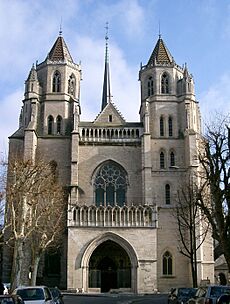John of Fécamp facts for kids
John of Fécamp (born in the early 1000s – died February 22, 1079) was an important Benedictine monk from Italy who lived in Normandy, France. He was one of the most widely read spiritual writers in the early Middle Ages, even before the famous book Imitation of Christ became popular much later. This time was known as a "Golden Age" for monasteries and learning. John wrote very popular books like Meditations of St. Augustine and Meditations, often using the names of other famous writers. He was born near Ravenna, Italy, and later became the Abbot (leader) of the Abbey of Fécamp in Normandy, where he died. People sometimes called him Jeannelin or Little John because he was quite short.
Life

In the early 1000s, John left his home in Italy. He might have lived as a hermit (someone who lives alone for religious reasons) for a while. He then traveled to France, probably because his uncle, William of Volpiano, invited him. William was also from Italy and was the abbot of the Abbey of Saint Bénigne in Dijon.
John joined William at the Abbey of Saint Bénigne. For several years, they worked together to improve how monks lived and worked in central and northern France. In 1017, William was asked to reform (improve) the Abbey of Fécamp and bring Benedictine monks there. He became the abbot of Fécamp, and John went with him.
At Fécamp, John became the prior, which is a leader just below the abbot. He held this job until 1028. When William retired and went back to Italy, he chose John to be the new abbot of Fécamp.
John was the abbot of Fécamp for the next fifty years. He was a great example of a traditional Benedictine monk. He worked very hard to manage the abbey and keep things organized. He made sure Fécamp's land was secure. When the Abbey of Saint Bénigne had problems with its leadership, John took charge of it too, along with his own abbey. He also helped reform two other monasteries.
John made Fécamp's school and library much better. By the 1070s, the library had 87 manuscripts (old handwritten books), almost all of which were added during his time as abbot.
In 1052, when Helinard became the Archbishop of Lyon, John was asked to become the Abbot of Dijon. At first, he tried to be abbot of both Fécamp and Dijon. But he found it too much work, so he gave up his role at Fécamp in 1056. Later in his life, he went on a special trip to the Holy Land. He was captured and put in prison by the Turks. He was finally able to return to France in 1076. He then went back to Fécamp, where he died in 1079.
Works
When John was the Abbot of St. Bénigne, he became close with Emperor Henry III and his wife, Agnes of Poitou. After Henry died, his widow Agnes asked John for spiritual guidance. For her, John wrote several books about spiritual practices and living a simple life. Some of his letters about life in the monasteries were also collected, including his important 'Letter to a Nun'.
John wrote his first book of prayers, called Confessio Theologica (Theological Confession), before 1018. He later changed and updated this book to create a second one, Libellus de scripturis et verbis patrum (The Little Book of Writings and Words of the Fathers). This second book became very popular in the later Middle Ages, but it was known as The Meditations of Saint Augustine.
He also wrote a book called Lament over Lost Leisure and Solitude.
Another important work by John was Meditationes (Meditations). Parts of this book were widely read in the later Middle Ages. However, these parts were often thought to be written by more famous authors.
For a long time, almost all of John's writings were known under fake names (pseudonyms) like Ambrose, Augustine, and Bernard of Clairvaux. Because of this, people didn't really understand his own ideas until the 20th century. It is only recently that we've realized he was one of the most widely read spiritual writers until the Imitation of Christ became popular at the end of the Middle Ages.
See also
- André Wilmart

